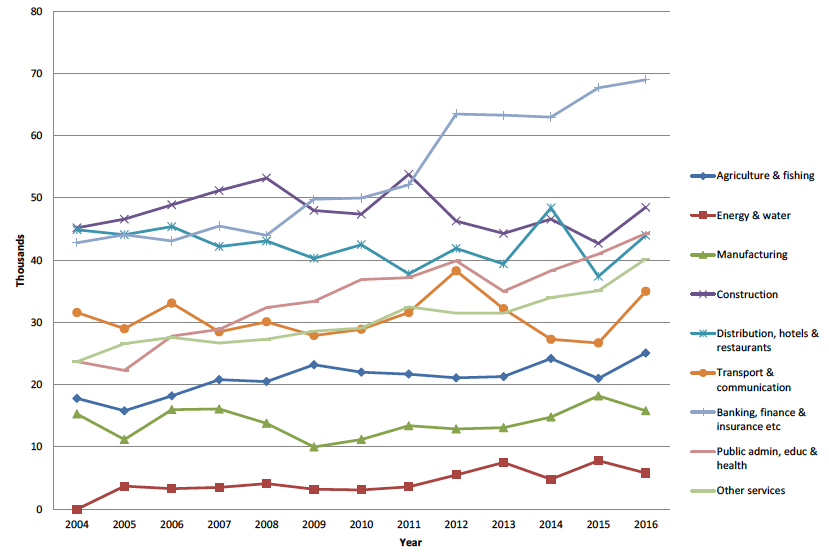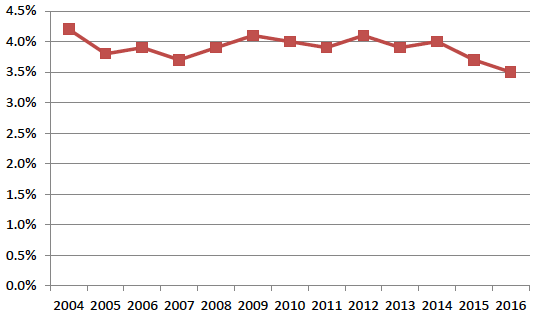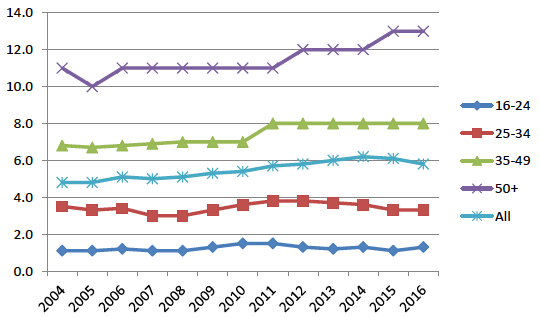Technological change and the Scottish labour market
A joint research report between Scottish Government and SUC assessing the potential impact of automation on Scottish work places.
Section 2: What does the evidence tell us about what is happening in Scotland?
Labour demand
Scotland’s labour market is performing strongly. Over the year to November – January 2018, the employment rate has increased and the inactivity rate and unemployment rate have both fallen. More people are moving into full-time jobs, with full-time employment up 22,000 over the past year. Scotland continues to outperform the UK on female and youth employment, unemployment and inactivity rates.
The headline statistics therefore do not currently support the argument that technological change is already exerting a negative effect on final labour demand in Scotland.
Trends
The STUC and Scottish Government agree that placing undue emphasis on the headline figures can obscure deeper labour market trends. A number of trends, most obviously the historic weakness in real wage growth, but also the increasing prevalence of atypical forms of work (e.g. self-employment, zero hours contacts and agency work), suggest that labour demand may not be as strong as the headline figures indicate.
Before examining the extent to which technological change may be influencing the Scottish labour market it might be helpful to examine current trends:
i) Although total employment is now close to historically high levels and rates, full-time employment has only recently returned to the levels seen in 2008. Part-time employment now appears to be stabilizing at around 700,000, more than 10% above pre-crisis levels.
ii) Self-employment has driven the overall increase in employment since the recession with part-time self-employment increasing from 21% to 28% of all self-employed.
iii) In 2016 74% of those who are self-employed are in high/medium skilled occupations. However the largest percentage growth has been in the occupations classed as ‘low skilled’ for example ‘Elementary Cleaning, Administration occupations’. Sectors registering significant growth, since 2004, include Energy, Public Administration, Education and Health (likely to be attributable to growth in the care sector) Banking and Finance and Other Services. Construction, Transport and Communications and Manufacturing registered much slower growth and Distribution, Hotels and Restaurants is the only sector to register contraction in the numbers of self-employed. There has been an increase across the majority of occupations with the largest growth within Caring, Leisure and Other Service occupations. Although subsector data is unavailable this is likely to have been driven by increases in the care sector. This sector includes care, services and Leisure and Travel Services.
Chart 1: Level of all self-employment by industry, 16+, Scotland, 2004-16

Source: Annual Population Survey
iv) 71,000 people in Scotland reported being on a zero-hour contract in Oct-Dec 2017 around 2.7% of all those in employment although this is slightly lower than the rate in the UK as a whole (2.8%). It should be noted that zero hours jobs more than tripled between 2012-16 although this is likely to be at least partly attributable to greater awareness and reporting of contract type. [26]
v) Temporary employment has remained remarkably stable over the last decade and is around 10% lower than when the series began in 2004.
vi) Although agency workers are less prevalent in Scotland (1.5% of all workers) compared to the UK as a whole (2.5% of all workers) there has been an increase in recent years. Agency workers are concentrated in lower skilled occupations, tend to earn less, are more likely to be from disadvantaged groups, and want to have more secure employment – 60% of temporary agency workers would prefer to be in a more permanent job. [27]
vii) There seems to be less dynamism in the labour market than might be expected with the high employment and low unemployment rates:
- Job to job changes have fallen: in 2004 2.9% of all employed people had moved job in the past three months, falling to 1.9% in 2016
- The number of people working two jobs fell from 101,000 (4.5% of all employed people) to 89,000 (3.5%) between 2004-2016.
- Contrary to popular perception, job tenure is actually rising: median tenure has risen from 4.8 years to 5.8 years between 2004 and 2012, only the 25-34 age group has seen a small decrease. (It should be noted that median job tenure is affected by a number of factors including the increase in older workers and women remaining in the labour market for longer so a year for year comparison is not comparing like for like).
Chart 2: Percentage of all employed who left paid job for a new job in the last 3 months, 16+, Scotland, 2004-16

Source: Annual Population Survey January to December 2016
Chart 3: Percentage of all employed with a second job, 16+, Scotland, 2004-16

Source: Annual Population Survey January to December 2016
Chart 4: Median tenure in years among employed by age, 16+, Scotland, 2004-16

Source: Annual Population Survey January to December
Atypical work and technology
The significant increase in self-employment across most sectors and occupations is probably the most significant post crisis labour market trend and there are a number of reasons to believe that technological developments help explain the increase: ICT products have lowered the cost of starting a business and networking software facilitates easier matching of self-employed workers with customers. The unbundling of production processes discussed in the introduction may also open up more opportunities for self-employed workers.
However technology is only one of many factors influencing the increase in self-employment:
- The UK tax system incentivizes self-employment particularly for higher skill/pay groups. Self-employed workers pay less NICs and employer NICs don’t apply. An employer who changes the status of employed staff to self-employed will make significant savings. The number of self-employed workers increased sharply in 2003 when a change if Corporation Tax eliminated tax on the first £10,000 of company profits and allowed directors of small firms to save income tax by taking salaries as profits.
- Changing individual preferences: despite lower wages and greater insecurity, people value the flexibility of self-employment.
- Demographics: over the past decade the number of people aged over 65 in employment in Scotland has increased by over 200%. Older workers are more likely to be self-employed.
If, as many current popular narratives suggest, technology was helping turn Scotland and the UK into nations of’ multiple jobbers and portfolio jugglers’, we might be expected to see this greater dynamism manifest in statistics for job tenure, job to job moves and second jobs. Yet the statistics reveal subdued labour market dynamism despite the high levels of employment.
In summary,
1. There is an understandable and increasingly widespread anxiety about the consequences of the current wave of technological change for the Scottish labour market.
2. Some current labour market trends - including growing prevalence of zero-hour contracts and, especially, rising self-employment - are a serious and legitimate concern for both the STUC and Scottish Government as they can lower job quality, increase economic insecurity, lower productivity and undermine inclusive growth.
3. However there is a risk of exaggerating the extent to which these trends are influenced by technology. The sharp increase in zero hours between 2012-2016 is at least partially attributable to a growing awareness and reporting of contract type and a variety of factors, not all negative, have conflated to drive the substantial increase in self-employment. Insecure, exploitative forms of employment have been a deeply embedded characteristic of the UK labour market since at least the widespread deregulation of the 1980s and 1990s. Technology also opens up opportunities for worker in terms of new jobs created and innovative, non-exploitative forms of flexible working.
4. The significant increase in self-employment across all skills groups is a distinguishing characteristic of the post crisis UK labour market and appears to have a number of contributory factors. The precise extent to which technology, in particular platform based employment, has contributed to the increase in Scotland is not yet wholly clear but does not appear to be the principal cause.
5. Statistics on tenure (rising), job to job moves (falling) and second jobs (falling) show that the labour market dynamism that might be anticipated given popular narratives around technological change actually remains subdued.
6. Overall, there is little evidence to suggest that technology is currently significantly ‘disrupting’ the Scottish labour market or that it is likely to do so in the short-medium term. The structure of the Scottish economy tends towards a slower rate of automation i.e. sectors where automation is most rapid do not have a large presence (e.g. automotive). The more pessimistic accounts of imminent job losses are based on flawed methodology and a lack of appreciation of the relationship between technological and economic feasibility.
7. If technology was a major factor driving change in the labour market then we might expect to see similar trends in other nations e.g. large increases in self-employment across OECD nations. That this doesn’t seem to be happening to the same extent as in the UK suggests that the origins of current trends are more likely found in the distinctive characteristics of the UK economy/labour market e.g. a tax system which incentivises self-employment, low collective bargaining coverage, relatively deregulated product and labour markets and industrial structure.
8. However, none of the above is to argue that impact of technological change is having no effect on the labour market or that its impact might not be significant in the longer term:
- new employment opportunities are already being created, and will continue to be, in the production and delivery of a wide range of new goods and services.
- even if its impact on aggregate labour demand is limited, technological change may have significant distributional consequences: job displacement will be unevenly spread across tasks, occupations, sectors and regions; there may be on-going polarisation within the labour market and it is reasonable to expect capital income to become increasingly concentrated.
- technology can facilitate both positive forms of flexible working and exploitative forms of management.
- the impact on workers may often be hidden e.g. jobs will change rather than disappear and there may be a lack of support and training to ease the transition.
Contact
There is a problem
Thanks for your feedback